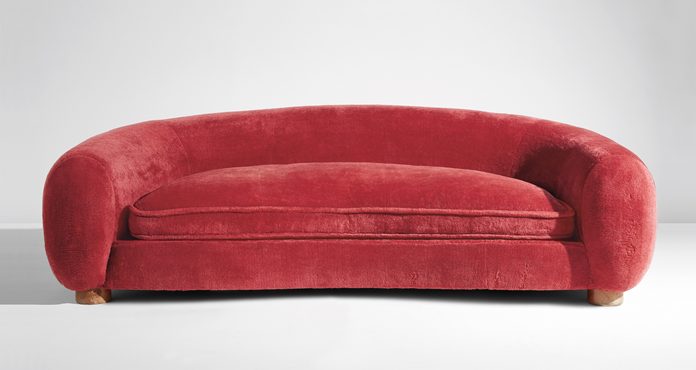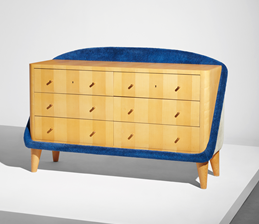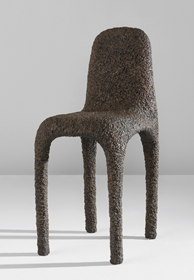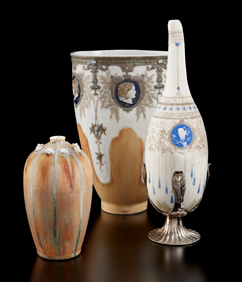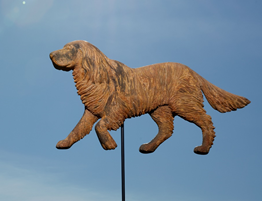|
PRESS RELEASE
French Post-War Design Leads Phillips’ Auction on 17 December
New York Sale to Also Include a Strong Selection of Italian Post-War Lighting, Calder Jewelry, Contemporary Design, and Ceramics, Along with 19th Century Weathervanes from the Collection of Florence Knoll Bassett
Jean Royère “Ours Polaire” sofa, 1950s Estimate: $300,000-500,000
NEW YORK – 21 NOVEMBER 2019 – On 17 December, Phillips will host its final auction of 2019 with the sale of Design in New York. Comprised of over 180 lots that bring together a variety of design movements from the past century, the auction will present an opportunity for collectors of all levels and interests to acquire exceptional examples of 20th and 21st century Design.
Cordelia Lembo, Phillips’ Head of Design, New York, said, “With a strong selection of French and Italian post-war design alongside contemporary pieces, Calder jewelry, and ceramics, this sale aims to continue Phillips’ strategy of bringing a new perspective to the traditional collecting categories. We are proud to offer works from esteemed private collections this season. On the heels of offering artwork from Florence Knoll Bassett’s personal collection in November, the December sale will include a selection of her prized weathervanes. We are also particularly honored to include exceptional examples of Art Nouveau and Art Deco ceramics and glass from the collection of Ann and Robert Fromer.”
The December sale offers a strong selection of French post-war design, anchored by an impressive selection of works by Jean Royère. Leading the auction is the red Ours Polaire sofa. Jean Royère first designed the Ours polaire sofa for the rooms he occupied in his mother’s apartment at 234 rue du Faubourg-Saint-Honoré on the occasion of re-decorating her residence in 1947. Initially the design was slow to gain momentum, but soon the sofa became ubiquitous in Royère’s interiors of the late 1950s and early 1960s. Today it is recognized as one of his most iconic and sought-after designs. The soft round form of the Ours is in keeping with Royère’s whimsical aesthetic as well as the biomorphic style already in full force in the 1950s. The present lot retains the original thick red upholstery, a color which Royère particularly favored for this design.
Also among the works by Royère is a Boule armchair, which was acquired in 1957 from the architect Nadim Majdalani in Beirut. Majdalani had met Jean Royère in Paris and subsequently, in the late 1940s, the two opened an office of decoration and architecture together, a union that would continue into the 1960s. Royère and Majdalani collaborated on a large number of both residential and commercial interiors throughout Lebanon, which at the time was experiencing a great deal of growth and new construction. A rare Œuf chest of drawers is an additional highlight by Royère in the auction. The chest of drawers was created following the Œuf chair of 1954; while the chair became a regular feature in his interiors, the other furniture is much less ubiquitous, documented in only a few places.
Three lots from Claggett Wilson’s Lewisohn Commission will also be offered, including a sideboard, an extendable dining table, and a set of twelve dining chairs. Wealthy and progressive members of New York society in the early 20th century, Mr. and Mrs. Sam Lewisohn found in Wilson a creative partner who conceived a highly original interior scheme. Wilson was a modernist American artist, whose paintings are now in the collections of the Smithsonian American Art Museum and The Metropolitan Museum of Art. Like many artists in New York at this time, Wilson did not discriminate among mediums, and in addition to painting and illustrating, he also designed costumes and sets. The diversity of his projects suggests he may have designed other pieces of furniture in addition to those for the Lewisohn dining room, now the only known extant examples. An article about Claggett Wilson, probably published circa 1933 in the Boston Evening Transcript (a photocopy survives in the archives of one of Wilson’s heirs), quotes Henri Matisse remarking on the room: “It is perhaps the most ideal background for my paintings I have yet seen.” Discovered in the 1970s and held in private collections until now, this is the first time the present suite of furniture has come to public market since 1939.
Claggett Wilson Set of twelve dining chairs, circa 1930, Estimate: $40,000-60,000 Extendable dining table, circa 1930, Estimate: $18,000-24,000 Offered as 2 separate lots
Leading the contemporary selection in the sale is Jeroen Verhoeven’s Lectori Salutem. Verhoeven’s work reinterprets Dutch design traditions through the means of modern technology, while looking at the way technology is developing at such lightning speed that we are becoming accustomed to it. His work ignited global attention when he created Cinderella Table, first realized in 2005-2006. Jeroen went on to create Lectori Salutem in 2010, taking the process and materials to entirely new heights. Working with the collaborative support of his twin brother Joep, Jeroen conceived a desk which would again be based on an historic silhouette, in this case taken from a drawing by François Linke. Instead of being carved out of a solid material, the piece was built of no less than 150 separate panels of stainless steel, assembled using 2,300 bolts.
Among the contemporary highlights is Max Lamb’s Bronze Poly Chair, a unique creation hailing from Lamb’s novel experimentations with form, material, and technique, designed in 2006. The chair was created using the lostfoam casting process, a highly unconventional production method for furniture making. Lamb submerges a polystyrene foam model of the chair into sand, then pours molten bronze over it to melt the foam, giving the chair its unique, beady surface. In this regard, the chair is both original and part of a larger editioned series, with one example currently belonging to the permanent collection of the San Francisco Museum of Modern Art.
Phillips is delighted to have the opportunity to offer ceramics form the collection of Ann and Robert Fromer, including examples by Paul Jeanneney, Taxile Doat, Auguste Delaherche, and more. Prescient collectors with a shared passion, the Fromers began acquiring decorative arts almost fifty years ago, a fact that is reflected in the knowledgeable scope of their collection which spans the late 19th through early 20th centuries. The Fromers’ collection aptly narrates the historicism and innovative spirit of this period, demonstrating how naturalism, Japanese influences, and historic revivals of the late 19th century gave way to the progressively graphic and pictorial styles of Art Deco. In these early years of rediscovery, without the wealth of scholarship and market history now at our disposal, the Fromers nevertheless assembled a museum-worthy collection of the finest and most representative works of the period.
Phillips is also proud to offer two works of jewelry by Alexander Calder in the December Design auction. Created at the height of Calder’s recognition, when his designs adorned the fashionable intelligentsia of Europe and the United States, Calder’s delicate Cape Clasp and Six Circles brooch showcase artist’s ability to create wearable art. Delicately hand crafted, each unique piece adds another dimension to the experience of Calder’s work, allowing for a tangible, portable, and highly personal level of engagement. Created circa 1940, Six Circles is emblematic of the artist’s technical capability. The piece once belonged to artist Aviva Baal Teshuva and her husband Jacob—a renowned critic of modern and contemporary art who later authored a publication on Calder. Created in 1936 and boasting outstanding provenance, Cape Clasp once formed part of Mary Rockefeller Morgan’s collection, having been originally acquired by Nelson A. Rockefeller— the renowned collector, philanthropist, and 41st Vice President of the United States who also served as a Trustee, Treasurer, and President of New York's Museum of Modern Art at a time when the museum began to draw an equivalence between jewelry and contemporary art. An early work crafted in silver, the elegant clasp plays with sculptural possibilities within the realm of functional attire. A seemingly infinite loop of glistening silver speaks to the conceptual rigor of geometry while the asymmetrical fluted ends and hand-formed rivets recall the endearing whimsy of Calder’s early representational wire sculptures.
The Design sale also continues Phillips' offering of works from the collection of Florence Knoll Bassett. It may seem surprising that Knoll Bassett, the pioneer of the sleek aesthetic that came to define the postwar American office interior, collected nineteenth-century weathervanes. Though these sculptures may seem incongruous, this pairing highlights the tradition of so-called primitive art and modernism having a long intertwined history. Wassily Kandinsky mined Russian folk art for inspiration while Picasso and other artists working in Paris collected African carvings. Into the late 1950s, which is when Florence discovered weathervanes “on a whim” while on a trip to Paris with her second husband Harry Hood Bassett, early America continued to serve as inspiration for American artists as well as prominent collectors. While Florence Knoll Bassett does not seem to have included weathervanes in any of her office interiors, they do appear in images of her summer home in Vermont. She acquired the vanes in Vermont as well as in the many antiques stores located near the Knoll showroom in midtown Manhattan and treasured her collection enough to bring it with her when she and Bassett relocated to Coral Gables, Florida, in 1965 and finally to her last residence in Coconut Grove, where she displayed a group to striking effect in a custom grid-shaped display.
Auction: 17 December 2019 Auction viewing: 13-16 December Location: 450 Park Avenue, New York Click here for more information: https://www.phillips.com/auctions/auction/NY050219
### ABOUT PHILLIPS Phillips is a leading global platform for buying and selling 20th and 21st century art and design. With dedicated expertise in the areas of 20th Century and Contemporary Art, Design, Photographs, Editions, Watches, and Jewelry, Phillips offers professional services and advice on all aspects of collecting. Auctions and exhibitions are held at salerooms in New York, London, Geneva, and Hong Kong, while clients are further served through representative offices based throughout Europe, the United States and Asia. Phillips also offers an online auction platform accessible anywhere in the world. In addition to providing selling and buying opportunities through auction, Phillips brokers private sales and offers assistance with appraisals, valuations, and other financial services. Visit www.phillips.com for further information.
*Estimates do not include buyer’s premium; prices achieved include the hammer price plus buyer’s premium.
PRESS CONTACTS: NEW YORK - Jaime Israni, Senior Public Relations Manager jisrani@phillips.com +1 212 940 1398
|
|
PHILLIPS NEW YORK - 450 Park Avenue, New York, NY 10022 PHILLIPS LONDON - 30 Berkeley Square, London, W1J 6EX PHILLIPS HONG KONG - 14/F St. George’s Building, 2 Ice House Street, Central Hong Kong PHILLIPS GENEVA - Hôtel La Réserve, 301 Route de Lausanne, Geneva
VISIT US AT: www.phillips.com FOLLOW US ON: Twitter | Instagram | Vimeo | Facebook | LinkedIn | Weibo| WeChat (use QR Code to right) |
|

